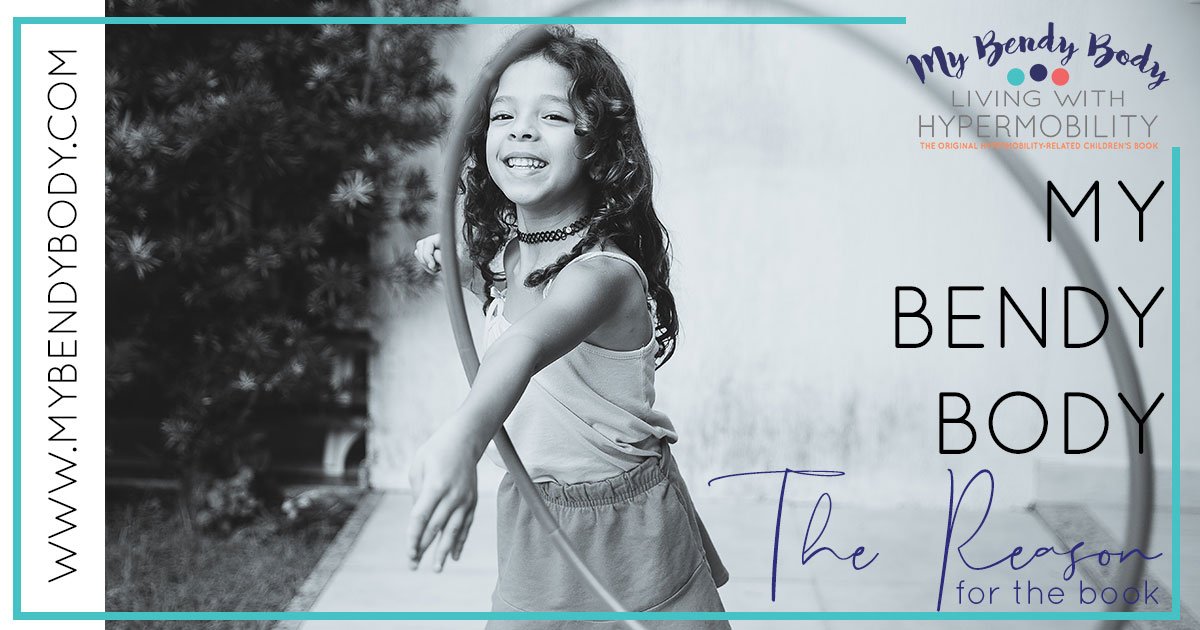A book for kids living with hypermobility
So, how did the My Bendy Body book for kids living with hypermobility come into being?
It was initially an idea that grew from a conversation with a parent about how to explain hypermobility to her daughter without scaring away her zest for life. I was working as a paediatric occupational therapist, and we were trying to work out how to communicate this particular situation to the child but also those who were caring for her. She was a vivacious four-year-old who just wanted to get the most out of life (possibly more than your average; I had a lot of trouble keeping up with her at times), but her hypermobility was starting to get in her way. We had to start educating her about keeping her joints safe and why that was so important. And realistically, we needed to find ways to begin buffering her against the teasing she was starting to get from other kids.
But kids aren’t just mini-adults. Right? You can’t just throw big words at them and hope they’ll catch on.
Kids need things explained in simple language. Short sentences + pictures = perfect.
Preview: My Bendy Body
Social stories are a big thing in paediatric therapy, and I realised that there was more than one child like the one sitting right in front of me. I always knew that whichever way we explained this to kids, it had to have a positive “I can still do things” tone because that is the most important message to express to these kids. I still can.
Sometimes one of the most challenging things for kids to understand is that even though there are some things they can’t do, it doesn’t mean they’re not good at anything. Sometimes we humans tend to generalise our negative traits, "if I’m bad at one thing, I’m bad at all things". Which isn’t true (we like to catastrophise a lot). We forget our strengths and remember our weaknesses.
I wanted to make sure that children with hypermobility, who are often known to have problems developing some of their fine and gross motor skills, understood and could be reminded often, that they could still do things - perhaps differently, or with some assistance, but they still CAN. That message is so important to get into children’s minds because giving up at the age of 5 is not an option; they have a lot of life left to live and an attitude of “I can do it, just differently to you” is much more helpful than a blanket “I can’t”.
There will be things they will face in life that they can’t do, and they need to know that that is OK. However, trying is very important; the same is true for everyone. As we know, kids can also be unbelievably resilient. They will bounce back from things that many adults find challenging. And so this book was about helping them to focus on their positives and their resilience; thinking about the skills they do have; the things they can do. And reminding them that even when things are hard, with some determination or some lateral thinking, they still can.
Added Extras
Another aspect I snuck into the book, which most probably didn’t pick up on but I hope is working subconsciously, was that by parents and carers reading this book to or with the child, they would be reminded that the child CAN do things for themselves too. Often parents and carers of kids with special needs jump in and help quickly, whether it’s because of time pressures or frustration, or not wanting the child to fail. But the child needs opportunities to practice and to learn to succeed.
And lastly, the other purpose of the book was to say
“HELLO! World! There are children (and adults) out there living with these hypermobility conditions, and they are REAL problems. They’re not making them up; they’re not trying to get attention, make a fuss, or get out of things. They’re doing the best they can every day of their life, just to show up and participate. Do them a favour, pay attention to their needs when they express them. Their pain is real, their fatigue is real, and all the other symptoms that go with their condition are real too. No-one makes this up for fun, especially not a 5-year-old!"
Surprisingly, the book has become quite popular with adults! I’ve had countless readers report that having such a simplistic way of explaining their condition and the truth that there are some things that they can’t do, but others they can, makes things much easier. Go for it! It’s not just limited to children!
All across the world, we have child care centres, family daycares, school libraries, hospitals, doctors offices, parents, grandparents and extended family members with copies of My Bendy Body on their shelves (in one of 3 different languages, soon to be 4) or iPads (English only).
Is there a copy of this book for kids living with hypermobility on your bookshelf yet? Buy yours HERE today!
"You should buy this if you have a little bendy or even if you are the bendy that live/work/play with a child. As a manager in an early childhood setting, I use this book to describe my body (and it’s bendyness) to the kids. I love this story!"
~ Jenny R, USA

